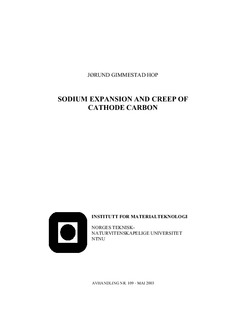| dc.contributor.author | Hop, Jørund Gimmestad | nb_NO |
| dc.date.accessioned | 2014-12-19T13:25:07Z | |
| dc.date.available | 2014-12-19T13:25:07Z | |
| dc.date.created | 2003-06-20 | nb_NO |
| dc.date.issued | 2003 | nb_NO |
| dc.identifier | 125029 | nb_NO |
| dc.identifier.isbn | 82-471-5595-8 | nb_NO |
| dc.identifier.uri | http://hdl.handle.net/11250/248735 | |
| dc.description.abstract | An apparatus to measure compressive creep in carbon materials has been developed. Using the final experimental set-up five material properties could be measured in each electrolysis experiment. Creep, sodium expansion, compressive strength and E-modulus were measured for 3 commercial cathode materials at 25 and 980 °C with and without electrolysis. The sodium diffusion coefficient (D) was calculated from the sodium expansion results.
Filler materials for cathode blocks, i.e., certain anthracite and petrol coke qualities, were exposed to sodium vapour to examine crack evolution.
Creep
The three commercial cathode materials were found to deform with time under compression at 25 °C, 980 °C and during electrolysis at 980 °C. Only samples from one block for each quality was studied, so care must be taken before extending the ranking to all classes of cathode materials. The ranking from low to high creep at 980 °C and during electrolysis was:
Semigraphitized < Anthracitic < Semigraphitic
The creep is larger during electrolysis than at 980 °C for all materials and the increase in creep from virgin to electrolysed material at 980 °C is largest for the anthracitic material. Repeated loadings did not influence the shape of the creep strain curve, which could be described by the expression (time)n. The magnitude of the creep strain ranged from 0.01 to 0.07 % with a load of 20 MPa held for one hour. The largest measured creep was approximately 0.35 % after 20 hours of electrolysis in the semigraphitic material.
The stress-strain diagram of the anthracitic material is unchanged before and after electrolysis and exhibits a more linear behaviour than in the other materials. The stress-strain diagram of the semigraphitic and semigraphitized materials changes after loading and tend to increase after electrolysis.
Cracks
All anthracite grains cracked to some extent after being exposed to sodium vapour at 800 °C. The lowest heat treated grains cracked the most. Cracks through grains were also found in the commercial material during electrolysis. In the petrol cokes only grains calcined to 1500 °C with a structure characterised by a gradient from mosaic to flow was observed to crack after exposure to sodium vapour at 800 °C.
Diffusion coefficient
The diffusion coefficient of sodium in carbon during electrolysis has been calculated with three different solutions of Fick’s law and is found to increase with current density and graphitic character of the material. Two of the calculations were based on the expansion of the sample (penetration from bottom and radial penetration) and one on a rather few measured sodium concentrations. The diffusion coefficient was calculated to be in the range 8-10-5 to 5-10-4 cm2/s at current densities from 0.06 to 0.88 A/cm2, which is around 10 times larger than reported before (Table 2.1). The cryolite ratio did not influence D as the saturation time for samples in acidic or basic melt was the same.
The ranking from larger to smaller diffusion coefficient in the studied materials was
Semigraphitized > Semigraphitic > Anthracitic
The diffusion coefficient increased with heat treatment temperature in some laboratory produced materials. | nb_NO |
| dc.language | eng | nb_NO |
| dc.publisher | Norges teknisk-naturvitenskapelige universitet, Fakultet for naturvitenskap og teknologi, Institutt for materialteknologi | nb_NO |
| dc.relation.ispartofseries | Dr. ingeniøravhandling, 0809-103X; 2003:44 | nb_NO |
| dc.subject | Materials science | en_GB |
| dc.subject | TECHNOLOGY: Materials science | en_GB |
| dc.title | Sodium expansion and creep of cathode carbon | nb_NO |
| dc.type | Doctoral thesis | nb_NO |
| dc.source.pagenumber | 176 | nb_NO |
| dc.contributor.department | Norges teknisk-naturvitenskapelige universitet, Fakultet for naturvitenskap og teknologi, Institutt for materialteknologi | nb_NO |
| dc.description.degree | dr.ing. | nb_NO |
| dc.description.degree | dr.ing. | en_GB |

